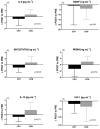Short-Term Resistance Training Supported by Whole-Body Cryostimulation Induced a Decrease in Myostatin Concentration and an Increase in Isokinetic Muscle Strength
- PMID: 32751455
- PMCID: PMC7432449
- DOI: 10.3390/ijerph17155496
Short-Term Resistance Training Supported by Whole-Body Cryostimulation Induced a Decrease in Myostatin Concentration and an Increase in Isokinetic Muscle Strength
Abstract
The study aimed to determine whether combining cryostimulation with resistance training would effectively increase muscle strength, and if so, whether this adaptation would be related to changes in circulating levels of exerkines (i.e., mediators of systemic adaptation to exercise). Twenty-five students completed 12 sessions of resistance training, each followed by either cryostimulation (n = 15, 3 min exposure at -110 °C) or passive recovery (n = 10). Prior to and post this intervention, participants performed two eccentric cycling bouts (before and after training). At these points, serum concentrations of muscle damage marker (myoglobin), exerkines (interleukin 6 (IL-6), interleukin 15 (IL-15), irisin, brain-derived neurotrophic factor), hypertrophy-related factors (myostatin, insulin-like growth factor 1), and muscle strength were measured. The applied procedure reduced the physiological burden of the second eccentric cycling bout and myoglobin concentrations only in the group subject to cryostimulation. The same group also exhibited decreased levels of myostatin (from 4.7 ± 1.7 to 3.8 ± 1.8 ng·mL-1, p < 0.05). A significant and large interaction between the group × time was noted in IL-15 concentration (p = 0.01, ηp2=0.27). Training and cryostimulation induced a positive and likely significant improvement of isokinetic muscle strength. Altogether, obtained results support the claim that resistance training combined with cold exposure modified muscle strength through modulation of myostatin and IL-15 concentrations.
Keywords: adaptation; growth factors; irisin; myokines; recovery.
Conflict of interest statement
The authors declare that the research was conducted in the absence of any commercial or financial relationships that could be construed as a potential conflict of interest.
Figures




References
-
- Paulsen G., Mikkelsen U.R., Raastad T., Peake J.M. Leucocytes, cytokines and satellite cells: What role do they play in muscle damage and regeneration following eccentric exercise? Exerc. Immunol. Rev. 2012;18:42–97. - PubMed
Publication types
MeSH terms
Substances
LinkOut - more resources
Full Text Sources

